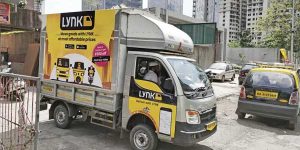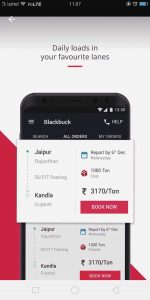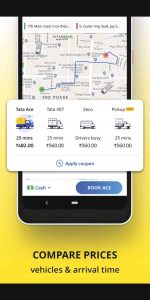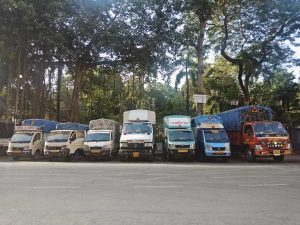Truck apps have come to increase the efficiency and earning-ability of truckers with the help of IoT and AI.
Story by : Bhushan Mhapralkar
To shift a fowler bed from Mira Road on the outskirts of Mumbai to Bhakti Park in the heart of Mumbai, Vinay hired a Maxximo mini-truck on the Porter app. He paid Rs.1500 for the task. It was approximately 50 per cent less than the Rs.2500 quoted by a Tata Ace operator that operates from his vicinity. For the operator, which ferried the bed, the engagement with Porter app platform for business has turned out to be beneficial. His income has gone up. He now has work coming to him rather than him facing an amount of downtime until a local trader or businessmen would engage his service. Like the Maxximo operator in Mumbai, Rishad Shaikh is happy to have engaged with a trucking app. in Lucknow, Uttar Pradesh. With a family of four to feed, he has seen his monthly income in the region of Rs.15,000 to Rs.19,000 jump to Rs.35,000 to Rs.40,000 a month. It has nearly doubled for Shaikh.
Looking at what is happening with Shaikh at Lucknow, or the Maxximo operator in Mumbai, a big disruption is being led by the trucking apps. If the income levels of Shaikh have witnessed a dramatic change after being introduced by his fellow operator friend to a voice-assisted multilingual trucking app, a clear disruption is playing out in the CV space; in the small CV space especially. It is more pronounced in the last mile connectivity segment. Apart from Porter, an app called BlackBuck is finding many takers. It is offered by a Bengaluru-based logistics firm, BlackBuck, and aimed squarely at the drivers. It is designed and engineered to improve the earnings of thousands of truckers by capturing and analysing data. Tapping a host of technologies, including telematics, artificial intelligence (AI), machine learning and Internet of Things (IoT), the app. is enabling truck drivers an opportunity to improve their uptime.
 If the slowdown and new axle norms have brought about a fall in demand and simultaneously in a fall in the utilisation level, the trucking apps. are helping most in the area of partial load most. With trucks in India said to have an average utilisation level of as low as 33 per cent, truck apps. like Porter and BlackBuck are charting out a significant change. What adds weight to their performance is their ability to sustain in an environment that has seen disruptions like demonetisation and GST (followed by the e-way bill). Withstanding a disruption like the change in axle norms that hiked the GVW of CVs by up to 15 per cent at once, trucking apps. are continuing to proliferate. They are doing so in an environment where the trucking fraternity has been inflicted with many wounds. Proving to be a disruptor with an ability to help earn more, trucking apps. are charting a good growth trajectory.
If the slowdown and new axle norms have brought about a fall in demand and simultaneously in a fall in the utilisation level, the trucking apps. are helping most in the area of partial load most. With trucks in India said to have an average utilisation level of as low as 33 per cent, truck apps. like Porter and BlackBuck are charting out a significant change. What adds weight to their performance is their ability to sustain in an environment that has seen disruptions like demonetisation and GST (followed by the e-way bill). Withstanding a disruption like the change in axle norms that hiked the GVW of CVs by up to 15 per cent at once, trucking apps. are continuing to proliferate. They are doing so in an environment where the trucking fraternity has been inflicted with many wounds. Proving to be a disruptor with an ability to help earn more, trucking apps. are charting a good growth trajectory.
 With many small and medium-scale transporters exiting the industry, or on the verge to do so, trucking apps are turning out to be a technology-intensive approach to doing business. Consider the Porter and Blackbuck app. for example, and the driver is given load assurance across multiple lanes and commodities to elevate his efficiency. He is provided Google Maps with trucking context to help him to follow the most optimal route. Providing him with the knowledge of fuel stations, toll gates and rest areas on his intended route, the onboard tracking devices supplied by the app. providers are proving to be quite beneficial for the operators. Said to include global positioning system that constantly feeds data to the backend system, the devices are also said to predict driver behaviour in context to him taking a certain route; when he will finish unloading, and will be available for the next job. The best part is, the driver is recommended a load nearby even before he finishes unloading. Thus, consistent demand mapping is one of the highlights of the new trucking apps. They help to optimise truck utilisation, empowering truck operators to earn more.
With many small and medium-scale transporters exiting the industry, or on the verge to do so, trucking apps are turning out to be a technology-intensive approach to doing business. Consider the Porter and Blackbuck app. for example, and the driver is given load assurance across multiple lanes and commodities to elevate his efficiency. He is provided Google Maps with trucking context to help him to follow the most optimal route. Providing him with the knowledge of fuel stations, toll gates and rest areas on his intended route, the onboard tracking devices supplied by the app. providers are proving to be quite beneficial for the operators. Said to include global positioning system that constantly feeds data to the backend system, the devices are also said to predict driver behaviour in context to him taking a certain route; when he will finish unloading, and will be available for the next job. The best part is, the driver is recommended a load nearby even before he finishes unloading. Thus, consistent demand mapping is one of the highlights of the new trucking apps. They help to optimise truck utilisation, empowering truck operators to earn more.
 Leveraging IoT and AI, the truck apps are making good use of new and emerging technologies like telematics. They are enabling truckers to connect in real-time with the shipper. Not only is it leading to higher utilisation, it is also leading to an improvement in shipping services. Apart from being able to predict the dispatch and arrival of the cargo, the big advantage the truck apps are coming to provide is efficient pricing. Consider the fact that Vinay paid Rs.1500 to accomplish his task through Porter rather than shell out Rs.2,500 to an operator with a similar size of truck in the vicinity who is essentially ‘offline’. What makes it even more interesting is how far the trucking apps have been expanding their scope of efficiency. Something that will benefit the operator who has engaged with him, and the end user too. A chat with a Blackbuck linked operator revealed that it provides some additional benefits to him in the form of a fleet card; in the form of tyres; in the form of insurance, and in the form of working capital credit.
Leveraging IoT and AI, the truck apps are making good use of new and emerging technologies like telematics. They are enabling truckers to connect in real-time with the shipper. Not only is it leading to higher utilisation, it is also leading to an improvement in shipping services. Apart from being able to predict the dispatch and arrival of the cargo, the big advantage the truck apps are coming to provide is efficient pricing. Consider the fact that Vinay paid Rs.1500 to accomplish his task through Porter rather than shell out Rs.2,500 to an operator with a similar size of truck in the vicinity who is essentially ‘offline’. What makes it even more interesting is how far the trucking apps have been expanding their scope of efficiency. Something that will benefit the operator who has engaged with him, and the end user too. A chat with a Blackbuck linked operator revealed that it provides some additional benefits to him in the form of a fleet card; in the form of tyres; in the form of insurance, and in the form of working capital credit.
If the engagement with apps like Backbuck have enabled the truckers to clock more kilometers every month, the big gain is the sense of belonging, security and respect. Ironic as it may sound, it is not rare or unusual to see a truck in most cities and towns in India with the Porter or Blackbuck app. mentioned on the sides. In the area of security, the trucking apps. have come to provide the option of a dashcam. It monitors driver behaviour by capturing his image and relaying it to the command centres which decipher the implications of the images by using algorithms. Upon detecting that the driver is drowsy, distracted, or driving rashly, the algorithm alerts the driver by sending him a message. Upon seeing no change, the truck owner is informed so that he can take charge of the situation.
 With CV makers penetrating the space by ensuring the evolution of their telematics programs, trucking apps. have been taking their model to the next level. They have been increasingly engaging with truck owners. They are enabling them to monitor, assess and compare the performance of their drivers, vehicles and accordingly make an informed decision. While acceleration and braking are some of the key differentiators, trucking apps. are dialling an amount of safety for certain. They are exploring a position where they could reduce the rate of accidents by as much as 50 per cent or more. If they could reduce the maintenance costs by a good margin as well.
With CV makers penetrating the space by ensuring the evolution of their telematics programs, trucking apps. have been taking their model to the next level. They have been increasingly engaging with truck owners. They are enabling them to monitor, assess and compare the performance of their drivers, vehicles and accordingly make an informed decision. While acceleration and braking are some of the key differentiators, trucking apps. are dialling an amount of safety for certain. They are exploring a position where they could reduce the rate of accidents by as much as 50 per cent or more. If they could reduce the maintenance costs by a good margin as well.
If Demonetisation exposed the Indian economy to transaction mediums other than cash, a few transporters were already on their way to cashless transactions involving their trucks and drivers. Since the announcement was made by the prime minister on the evening of November 08, 2016, many other transporters have turned to cashless transactions. Trucking apps. are using this shift to their advantage. With the coming of new norms like toll passage tags, trucking apps. have come to complement the use of fuel cards, FASTags, tracking and telematics devices, fuel sensors and dashcams. The number of trucks in India that use trucking apps. may be hard to arrive at, companies like Blackbuck are known to have 2,00,000 partner trucks. These could be serving 1,000 locations in India. Backed by investors like Goldman Sachs and Accel Partners among others, BlackBuck is investing heavily into product development and data sciences, which are the core of its marketplace approach.
Aiming at an estimated USD 250 billion worth of trucking and allied services market — something that CV makers like Ashok Leyland have been quite verbal of tapping with their digital solutions, app. providers like BlackBuck and Lynk, which has had over 3.5 lakh downloads thus far, are eyeing strong growth in the medium to long-term. Aligning themselves with the regulatory as well as market changes, they are looking at what the national logistics policy would unleash. It was announced by union finance minister Nirmala Sitharaman in her budget speech recently that a national logistics policy will be announced by the government soon. With the Indian logistics sector claimed to provide a livelihood to more than 22 million people, according to the Economic Survey 2017-18, the trucking app. companies are facilitating a decrease in logistics costs. This is said to be in-line with the government’s intention, and which could perhaps be the reason for the announcement of new axle norms.
 Leveraging big data, IoT and advanced analytics, Rivigo trucking app. company is looking at safer, faster and affordable trucking. Striving to address real-time demand-supply matching by creating traffic maps and by enabling efficient utilisation of resources, the company is working towards a platform that lets shippers and truckers to collaborate seamlessly. In a market that has been cash intensive and unorganised with a majority of transport companies family owned businesses, aggregator platforms like Rivigo are causing a flutter. They are even making the big players sit up and take notice. Even as Rivigo offers shippers the opportunity to take help of different transport solutions offered by it, and to deliver cargo quickly, the trucking app. companies as a whole are up against a market that is vast and fragmented. Consider this: India has about 230 micro truck markets.
Leveraging big data, IoT and advanced analytics, Rivigo trucking app. company is looking at safer, faster and affordable trucking. Striving to address real-time demand-supply matching by creating traffic maps and by enabling efficient utilisation of resources, the company is working towards a platform that lets shippers and truckers to collaborate seamlessly. In a market that has been cash intensive and unorganised with a majority of transport companies family owned businesses, aggregator platforms like Rivigo are causing a flutter. They are even making the big players sit up and take notice. Even as Rivigo offers shippers the opportunity to take help of different transport solutions offered by it, and to deliver cargo quickly, the trucking app. companies as a whole are up against a market that is vast and fragmented. Consider this: India has about 230 micro truck markets.
With the market largely divided between full-load and partial-load, trucking apps. like Trukky are making clever use of data to increase their reach. In and around Kolkata, shippers take to a trucking app. called OXA, which is known to offer transportation of cargo at reasonable rates. Inspired by trucking apps., there are apps. for services like ambulances that are springing up. For all the data, including real-time tracking and more that the trucking apps. have come to offer, what needs to improve is the reliability of the truck operators that engage with them. Challenges like these will not just test the resilience of trucking app. providing companies, they will lead them beyond their status as startups. Once the trucking app companies find themselves on the right side of profits, it would be safe to claim that truck apps. have arrived.




















